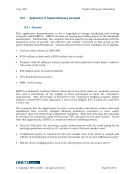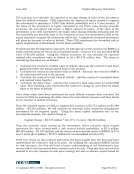June 2007 Capital Adequacy Extension © Copyright 2007, CCRO. All rights reserved. Page 81 of 92 The company quickly realized that they needed to employ a capital adequacy framework to address these issues as they related to equity and financial liquidity. This framework would require building a financial model which would: • Identify the major risks facing the firm and model the company’s exposures to these risks. • Simulate the company’s operations over the next 5 years (with and without the increased sales) along with the corresponding financial results. • Determine equity and liquidity requirements in regards to the risks faced by the company. 10.2.2. Modeling Approach EMTCo’s Chief Risk Officer (CRO) briefed the company’s executives about the challenges of simulating the firm’s operations over the next 5 years. She stated that any model used would need to be dynamic enough to make future adjustments, consistent with management’s strategy, as the business environment changed. She also elaborated on how the firm’s portfolio was constantly changing with new deals and that each time a new power deal was evaluated it had to be priced based on its risks (credit, market and operative), the firm’s pricing strategy and that period’s forward prices. Furthermore, her risk management group was constantly updating the future power positions based on the firm’s hedging strategy as new deals were consummated and volume exposures changed. She indicated that these management intervention dynamics created causal and non-linear relationships which created problems in accurately forecasting future economic outcomes. 10.2.3. Agent Based Modeling Technique31 Recognizing these challenges, the CRO recommended the use of an agent-based model which involves a simulation approach that utilizes agents to address dynamic behavior caused by management interventions. By specifying in the model the firm’s rules on hedging and pricing, the model’s “agent” could invoke adjustments similar to management’s actions under the same conditions. She also indicated that this approach can also be applied to other situations where the firm would make financial adjustments as economic and business conditions changed. The CRO went on to describe the agent based modeling technique to the company’s executives as a methodology that can model both dynamic and interactive behavior and provide a more effective solution to an otherwise difficult computational problem. She detailed how the agent is a self-contained, virtual entity possessing rules describing how it will operate and react under different circumstances and that the modeling utilizes 31Hightower, Lee. “Economic Capital Optimization for Oil Firms”, Society of Petroleum Engineers, SPE 108163, Presented at the SPE Hydrocarbon Economics and Evaluation Symposium in Dallas, Texas, April 2 -3, 2007.
Purchased by unknown, nofirst nolast From: CCRO Library (library.ccro.org)




























































































